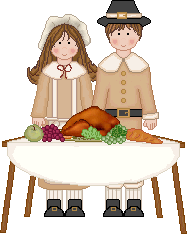|
First Thanksgiving

There were
people called the Pilgrims, who were fleeing religious prosecution in
their native England. In 1609 a group of Pilgrims left England for the
religious freedom in Leiden, The Netherlands, where they lived and
prospered. After a few years their children were speaking Dutch and had
become attached to the dutch way of life. This worried the Pilgrims. They
considered the Dutch frivolous and their ideas a threat to their
children's education and morality. So some of them decided to leave The
Netherlands and move to the New World, America. The voyage was financed by
a group of London investors who were promised produce from America in
exchange for their assistance.
On Sept. 6,
1620 the Pilgrims set sail for the New World on a ship called the
Mayflower. They sailed from Plymouth, England and aboard were 44 Pilgrims,
who called themselves the "Saints", and 66 others ,whom the Pilgrims
called the "Strangers." The long trip was cold and damp and took 65 days.
Since there was the danger of fire on the wooden ship, the food had to be
eaten cold. Many passengers became sick and one person died by the time
land was sighted on November 10th. The long trip led to many disagreements
between the "Saints" and the "Strangers". After land was sighted a meeting
was held and an agreement was worked out, called the Mayflower Compact,
which guaranteed equality and unified the two groups. They joined together
and named themselves the "Pilgrims."

The Pilgrims
had originally intended to go to Virginia, where they would have been
under the jurisdiction of the London Company, one of two English companies
that had been chartered to colonize North America. But they were blown off
course and had no grant to settle in the region controlled by the Plymouth
Company, the other English company. Thus the Pilgrims drew up the
Mayflower Compact. All adult male passengers on the ship were required to
sign it. Under this informal agreement or covenant, government was based
on consent of the governed, an important precedent for the development of
American democracy. All colonists had to obey the laws that were enacted.
The first
winter was devastating to the Pilgrims. The cold, snow and sleet was
exceptionally heavy, interfering with the workers as they tried to
construct their settlement. March brought warmer weather and the health of
the Pilgrims improved, but many had died during the long winter. Of the
110 Pilgrims and crew who left England, less that 50 survived the first
winter.
 On March 16,
1621 , what was to become an important event took place, an Indian brave
walked into the Plymouth settlement. The Pilgrims were frightened until
the Indian called out "Welcome" (in English!). On March 16,
1621 , what was to become an important event took place, an Indian brave
walked into the Plymouth settlement. The Pilgrims were frightened until
the Indian called out "Welcome" (in English!).
His name was
Samoset and he was an Abnaki Indian. He had learned English from the
captains of fishing boats that had sailed off the coast. After staying the
night Samoset left the next day. He soon returned with another Indian
named Squanto who spoke better English than Samoset. Squanto told the
Pilgrims of his voyages across the ocean and his visits to England and
Spain. It was in England where he had learned English. Squanto's
importance to the Pilgrims was enormous and it can be said that they would
not have survived without his help. It was Squanto who taught the Pilgrims
how to tap the maple trees for sap. He taught them which plants were
poisonous and which had medicinal powers. He taught them how to plant the
Indian corn by heaping the earth into low mounds with several seeds and
fish in each mound. The decaying fish fertilized the corn. He also taught
them to plant other crops with the corn.
The harvest
in October was very successful and the Pilgrims found themselves with
enough food to put away for the winter. There was corn, fruits and
vegetables, fish to be packed in salt, and meat to be cured over smoky
fires. The Pilgrims had much to celebrate, they had built homes in the
wilderness, they had raised enough crops to keep them alive during the
long coming winter, they were at peace with their Indian neighbors. They
had beaten the odds and it was time to celebrate.
The Pilgrim
Governor William Bradford proclaimed a day of thanksgiving to be shared by
all the colonists and the neighboring Native Americans. They invited
Squanto and the other Indians to join them in their celebration. Their
chief, Massasoit, and 90 braves came to the celebration which lasted for 3
days. They played games, ran races, marched and played drums. The Indians
demonstrated their skills with the bow and arrow and the Pilgrims
demonstrated their musket skills. Exactly when the festival took place is
uncertain, but it is believed the celebration took place in mid-October.
This event becomes known as the first American Thanksgiving.

| Back to Thanksgiving Menu |
| Back
to Holiday Land |
| Back to
Our Home |
Page created: Oct 4, 2004
Last updated: Oct 4, 2004
Information is from
Encarta and
Holidays Net.
Graphics are from
Graphics by
Irene, Graphics by Grace (not online anymore). |